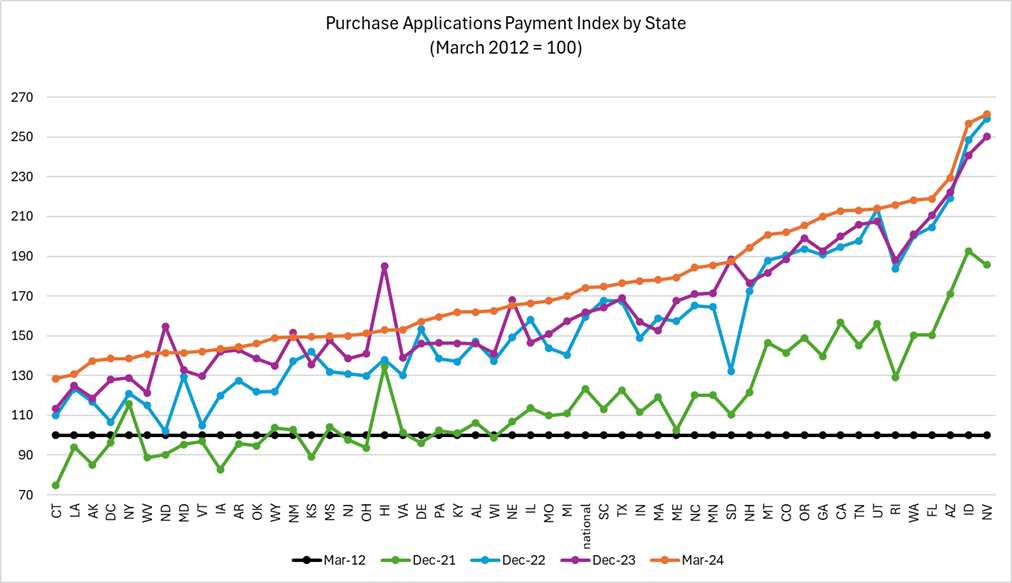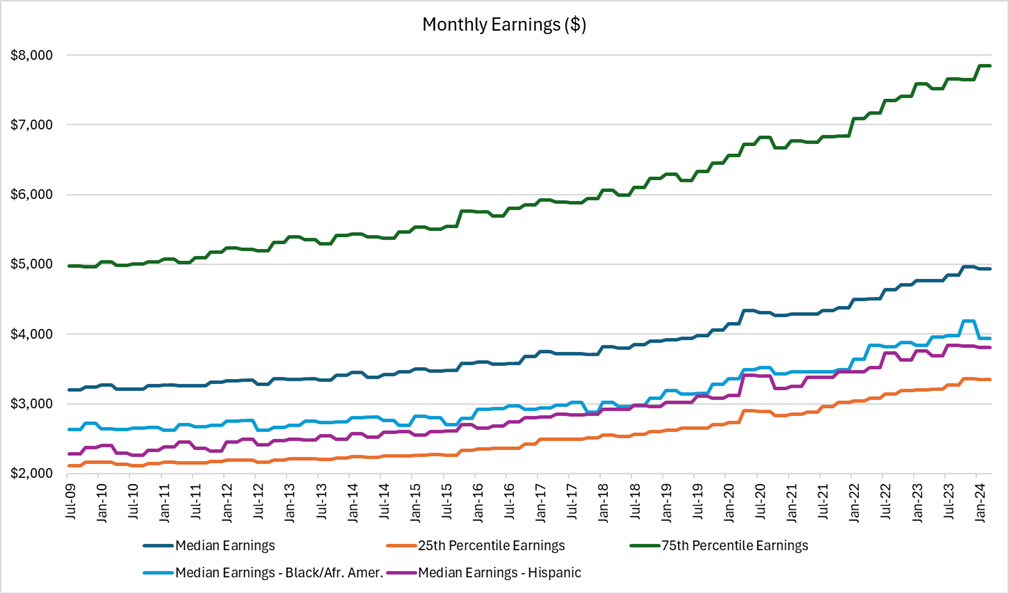Mortgage Application Payments Remained Flat in March
April 26, 2024
WASHINGTON, D.C. (April 26, 2024) – Homebuyer affordability declined in March, with the national median payment applied for by purchase applicants increasing slightly to $2,201 from $2,184 in February. This is according to the Mortgage Bankers Association's (MBA) Purchase Applications Payment Index (PAPI), which measures how new monthly mortgage payments vary across time – relative to income – using data from MBA’s Weekly Applications Survey (WAS).
“Homebuyer affordability conditions remain volatile as recent economic data continues to show that the economy and job market are strong. These factors will keep mortgage rates at elevated levels for the near future, sidelining some prospective buyers from entering the housing market,” said Edward Seiler, MBA’s Associate Vice President, Housing Economics, and Executive Director, Research Institute for Housing America. “While rates remain elevated and housing supply is low, we do expect to see renewed activity as mortgage rates decline to low-to-mid 6 percent range by the end of the year.”
An increase in MBA’s PAPI – indicative of declining borrower affordability conditions – means that the mortgage payment to income ratio (PIR) is higher due to increasing application loan amounts, rising mortgage rates, or a decrease in earnings. A decrease in the PAPI – indicative of improving borrower affordability conditions – occurs when loan application amounts decrease, mortgage rates decrease, or earnings increase.
The national PAPI (Figure 1) increased 0.8 percent to 174.2 in March from 172.8 in February. Median earnings were up 3.5 percent compared to one year ago, and while payments increased 5.2 percent, the strong earnings growth means that the PAPI is up 1.6 percent on an annual basis. For borrowers applying for lower-payment mortgages (the 25th percentile), the national mortgage payment increased to $1,488 in March from $1,473 in February.
The Builders’ Purchase Application Payment Index (BPAPI) showed that the median mortgage payment for purchase mortgages from MBA’s Builder Application Survey increased to $2,556 in March from $2,534 in February.
Additional Key Findings of MBA's Purchase Applications Payment Index (PAPI) – March 2024
- The national median mortgage payment was $2,201 in March—up $17 from February. It is up by $108 from one year ago, equal to an 5.2% increase.
- The national median mortgage payment for FHA loan applicants was $1,898 in March, up from $1,872 in February and up from $1,755 in March 2023.
- The national median mortgage payment for conventional loan applicants was $2,222, up from $2,194 in February and up from $2,145 in March 2023.
- The top five states with the highest PAPI were: Nevada (261.5), Idaho (256.9), Arizona (229.9), Florida (219.1), and Washington (218.2).
- The top five states with the lowest PAPI were: Connecticut (128.5), Louisiana (130.7), Alaska (137.3), DC (138.6), and New York (138.6).
- Homebuyer affordability decreased for Black households, with the national PAPI increasing from 179.0 in February to 180.4 in March.
- Homebuyer affordability decreased for Hispanic households, with the national PAPI increasing from 165.1 in February to 166.4 in March.
- Homebuyer affordability decreased for White households, with the national PAPI increasing from 175.5 in February to 176.8 in March.



About MBA’s Purchase Applications Payment Index
The Mortgage Bankers Association’s Purchase Applications Payment Index (PAPI) measures how new mortgage payments vary across time relative to income. Higher index values indicate that the mortgage payment to income ratio (PIR) is higher than in a month where the index is lower. Contrary to other affordability indexes that make multiple assumptions about mortgage underwriting criteria to estimate mortgage payment level, PAPI directly uses MBA’s Weekly Applications Survey (WAS) data to calculate mortgage payments.
PAPI uses usual weekly earnings data from the U.S. Bureau of Labor Statistics’ Current Population Survey (CPS). Usual weekly earnings represent full-time wage and salary earnings before taxes and other deductions and include any overtime pay, commissions, or tips usually received. Note that data are not seasonally adjusted.
MBA’s Builders’ Purchase Application Payment Index (BPAPI) uses MBA’s Builder Application Survey (BAS) data to create an index that measures how new mortgage payments vary across time relative to income, with a focus exclusively on newly built single-family homes. As with PAPI, higher index values indicate that the mortgage payment to income ratio (PIR) is higher than in a month where the index is lower. To create BPAPI, principal and interest payment amounts are deflated by the same earnings series as in PAPI.
The rent data series calculated for MBA’s national mortgage payment to rent ratio (MPRR) comes from the U.S. Census Bureau’s Housing Vacancies and Homeownership (HVS) survey’s median asking rent. The HVS data is quarterly, and as such, the mortgage payment to rent ratio will be updated quarterly. The HVS data is quarterly, and as such, the mortgage payment to rent ratio will be updated quarterly. MPRR data was not included in the March 2024 data.
For additional information on MBA’s Purchase Applications Payment Index, click here.
